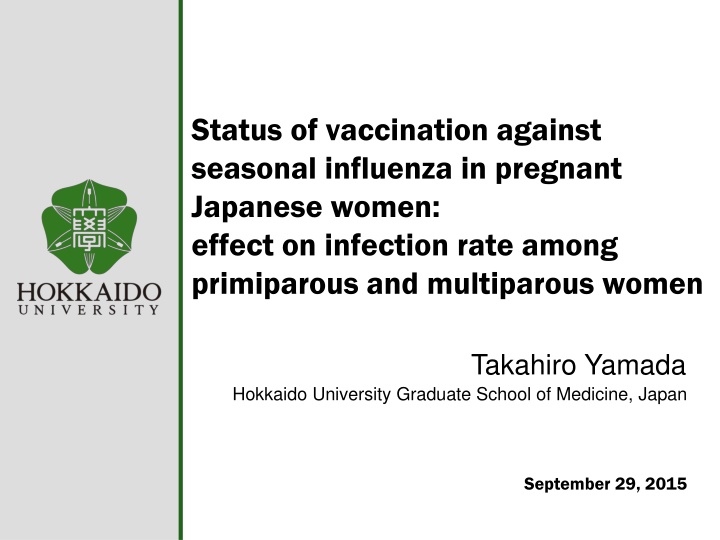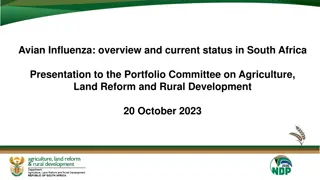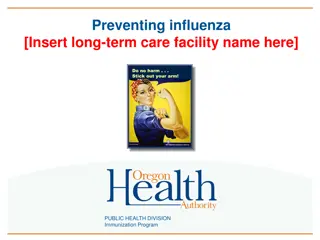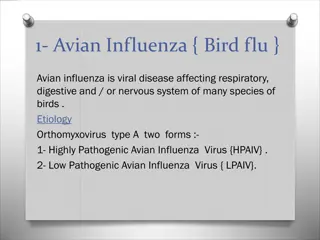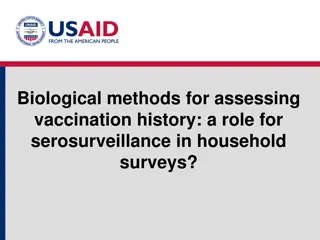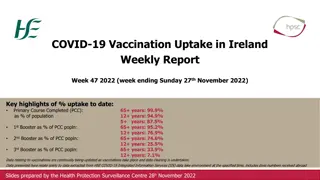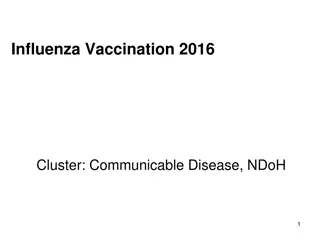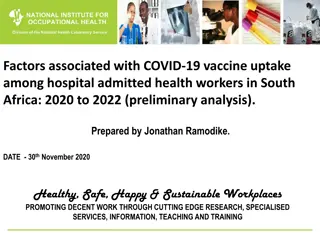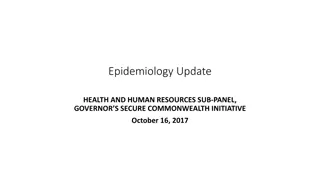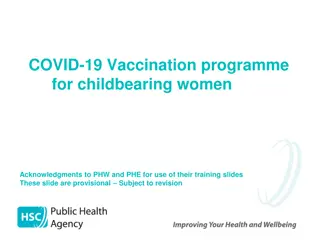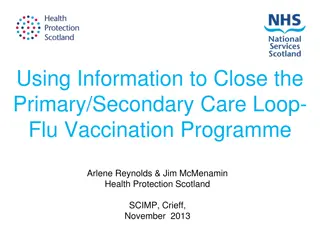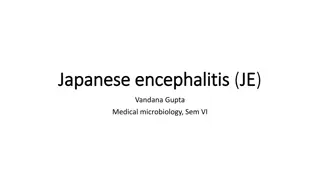Vaccination Status and Influenza Infection Among Pregnant Japanese Women
This study explores the impact of seasonal influenza vaccination on infection rates among pregnant Japanese women, focusing on primiparous and multiparous individuals. It discusses the background of influenza-related complications in pregnant women, presenting data on maternal mortality during the H1N1 pandemic and vaccination effectiveness. The research also examines factors like maternal age and birth weight of infants in relation to infection rates.
Download Presentation

Please find below an Image/Link to download the presentation.
The content on the website is provided AS IS for your information and personal use only. It may not be sold, licensed, or shared on other websites without obtaining consent from the author.If you encounter any issues during the download, it is possible that the publisher has removed the file from their server.
You are allowed to download the files provided on this website for personal or commercial use, subject to the condition that they are used lawfully. All files are the property of their respective owners.
The content on the website is provided AS IS for your information and personal use only. It may not be sold, licensed, or shared on other websites without obtaining consent from the author.
E N D
Presentation Transcript
Status of vaccination against seasonal influenza in pregnant Japanese women: effect on infection rate among primiparous and multiparous women Takahiro Yamada Hokkaido University Graduate School of Medicine, Japan September 29, 2015
1 Today s presentation 1. No maternal mortality from pandemic (H1N1) 2009 occurred in Japan (Letter BMJ 2010 Aug 6 ) 2. Pandemic (H1N1) 2009 in pregnant Japanese women in Hokkaido (J Obstet Gynaecol Res 38: 130 6, 2012) 3. Vaccination during the 2013 2014 influenza season in pregnant Japanese women (Eur J Clin Microbiol Infect Dis 34:543-548, 2015) 4. Influenza 2014 - 2015 among pregnant Japanese women: primiparous vs. multiparous women (manuscript in preparation)
2 Background Pregnant women are at an increased risk of severe influenza-related complications. Evidence from several countries demonstrated increased hospitalization rates and higher rate of mortality in pregnant women during the influenza.
3 No maternal mortality from pandemic (H1N1) 2009 occurred in Japan (Letter BMJ 2010 Aug 6 ): Our first report Japan Australia USA Canada China district/ country Hokkaido, Japan Calfornia, USA -Oct. 2009 -Dec. 2009 Study period Dec,2009- May, 2010 July, 2009- May, 2010 May, - Oct, 2009 What is the reasons for this lack of maternal deaths in Japan? Apr. - Aug.2009 Apr, -Aug. 2009 Admission 6 74 278 102 509 85 4328 (2.25% of pregnant patients ICU 0 47 (16.9% of admitted patients) 22 21.6%% of admitted patients 115 (22.6%% of admitted patients) 16 (18.8%% of admitted patients) 593 13.7%% of admitted patients death 3(1.08% of admitted patients) 8 7.8% of admitted patients 30 (5.89% of admitted patients) 4 (4.7% of admitted patients) 326 7.5% of admitted patients 0 0
4 Pandemic (H1N1) 2009 in pregnant Japanese women in Hokkaido (J Obstet Gynaecol Res 38: 130 6, 2012): 2ndreport Background and Aims: The reasons for the lack of maternal deaths from pandemic (H1N1) 2009 remain unknown. This questionnaire survey was performed to investigate how many pregnant women were infected, how many women took antiviral drugs for prophylaxis or treatment, and the rate of vaccination effectiveness. Methods: Questionnaire study for 20,500 postpartum women Study period: Dec 2009 - May 2010
5 Maternal age and birth weight of infants Infected 268* Non-infected 7,267 p-value No. of women Age (years old) -19 20-24 25-29 30-34 35-39 40- unknown Birth-weight of infants(g) -1,499 1,500-1,999 2,000-2,499 2,500-2,999 3,000- unknown 0.1823 6 (2.2%) 25 (9.3%) 80 (29.9%) 85 (31.7%) 64 (23.9%) 6 (2.2%) 2 (0.8%) 85 (1.2%) 816 (11.2%) 2,209 (30.4%) 2,571 (35.4%) 1,335 (18.4%) 170 (2.3%) 81 (1.1%) There were no significant differences in the distributions of maternal age or birth weight of infants between the infected and non- infected women. 0.1319 3 (1.1%) 0 (0.0%) 21 (7.9%) 107 (39.9%) 135 (50.6%) 2 (0.76%) 28 (0.39%) 51 (0.70%) 457 (6.3%) 2,809 (38.7%) 3,901 (53.7%) 22 (0.30%) Respondents: 7535
6 Influenza and preterm delivery Influenza did not significantly increase the rate of preterm delivery. However, if the hospitalization needed, the risk of preterm birth is increased. (Nakai A et al., J Infect. 2011; 62:232-233) Risk of preterm birth/abortion among 181 women who needed hospitalization. Characteristics Japana Overall Pneumonitis Absent 164 2/164(1.2) Present 17 1/17(5.9) No. of women Abortion at<22w NA Preterm birth 22-31 weeks 32-36 weeks Term birth *p < 0.01 vs Japan (national statistics) aNational data of Japan in 2008 were presented as a comparison group. 1,091,156 181 3/181(1.7) 7876/1,091,156 (0.7) 54,932/1,091,156 (5.0) 1,028,348/1,091,156 (94.2) 152/178 (85.4) * 141/162 (86.0) * #p < 0.05 vs women group without pneumonitis. 5/178 (2.8)* 21/178 (11.8) * 5/162 (3.1) * 16/162 (9.8) * 0/16 (0) 5/16 (29.4) *# 11/16 (68.8) *
7 Vaccination, Antiviral drug Infected(268) Non-infected(7267) p-value 11 (4.1%) 4,910 (67.6%) Vaccination Antiviral drug Prophylaxis only 4 (1.5%) Treatment only Both <0.0001 213 (2.9%) 0.1948 93 (34.3%) 136 (50.8%) More than 60% of candidates were vaccinated within 1.5 months after the availability of vaccine and half of all infected women had taken prophylactic antiviral drug after coming into close contact with an infected person
Vaccination reduced infection by 89% in pregnant Japanese women 8 Infection rate with pandemic (H1N1) 2009 according to the status of vaccination at after December in Hokkaido Vaccinated 4,921 11 (0.224%) Non-vaccinated 2,407 50 (2.08%) p-value No. of women No. of infected <0.0001
9 Summery of first questionnaire survey Pregnant Japanese women had a high level of concern regarding pandemin (H1N1) 2009, went to some effort to avoid contracting the influenza by taking antiviral drugs and vaccination. This behaviour may have contributed to the lack of maternal mortality associated with this pandemic in Japan. Vaccination reduced infection by 89% in pregnant Japanese women.
10 Vaccination during the 2013 2014 influenza season in pregnant Japanese women (Eur J Clin Microbiol Infect Dis 34:543-548, 2015): 3rdreport How many pregnant Japanese women are vaccinated against seasonal influenza? How many pregnant Japanese women contracted seasonal influenza before or after the pandemic (H1N1) 2009? The baseline level of concern regarding influenza among pregnant Japanese women? To prepare for future avian influenza epidemics.
11 Vaccination during the 2013 2014 influenza season in pregnant Japanese women (Eur J Clin Microbiol Infect Dis 34:543-548, 2015) We conducted the multi-center study to determine vaccination coverage against seasonal influenza and the prevalence rate of influenza infection among pregnant Japanese women during the 2013 2014 influenza season. This is the first study focusing on the behavior of pregnant Japanese women with regard to seasonal influenza.
Vaccination rates according to maternal age and Vaccination rates according to maternal age and experience of prior birth experience of prior birth 12 Age (year) 24 25 29 30 34 35 39 40 Overall *, Comparison between primiparous and multiparous women. , P < 0.05 vs. any other age category. , P < 0.05 vs. any other age category except women aged 25 29 years. 876 (51%) reported having received vaccination against influenza in or after October 2013. Women aged 24 years had a significantly lower vaccination rate than those aged 25 years (31% vs 53%, respectively; P=0.0000). Overall 39/124 (31%) 29/92 (32%) 171/332 (52%) 112/198 (57%) 59/134 (44%) 305/571 (53%) 156/299 (52%) 149/272 (55%) 0.5330 260/501 (52%) 106/222 (48%) 154/279 (55%) 0.0974 101/185 (55%) 44/92 (48%) 876/1713 (51%)447/903 (50%) 429/810 (53%) 0.1525 Primiparous Multiparous 10/32 (31%) P-value* 0.9772 0.0249 57/93 (61%) 0.0659
Comparison of women who did and did not contract Comparison of women who did and did not contract influenza influenza Infection with influenza Yes No. of women 87 Vaccinated 34 (39%) Primiparous 26 (30%) Maternal age (years) 29 21 (24%) 30 35 34 (39%) 35 32 (37%) 87 (5.1%) and 1626 (94.9%) women did and did not contract influenza, respectively. Although prior birth did not affect overall vaccination coverage (50% for primiparous vs. 53% for multiparous), multiparous women had a significantly higher rate of contracting influenza than primiparous women irrespective of vaccination status (5.6% vs. 2.2% [P=0.0216] with vaccination and 9.7% vs. 3.5% [P=0.0003] without vaccination, respectively). 13 No 1626 842 (52%) 877 (54%) P-value 0.0210 <0.0001 435 (27%) 537 (33%) 654 (40%) 0.5235 0.7088 0.2450
Vaccination and infection with influenza virus Vaccination and infection with influenza virus A and B A and B Vaccinated No. of women 876 Type of influenza virus A 24* (2.7%) B 7 (0.8%) Unknown 4 (0.5%) Overall 34 (3.9%) *, One was also infected with influenza virus B. The vaccination program of this season significantly reduced influenza infection rate by 35% (3.9% vs. 6.3% for women with and without vaccination, respectively; P=0.0272). 72 (83%) of the 87 infected women took antiviral agents for the treatment of influenza and 2 (2.3%) required hospitalization. 14 Unvaccinated 837 P-value 27* (3.2%) 16 (1.9%) 11 (1.3%) 53 (6.3%) 0.5542 0.0455 0.0569 0.0272
15 Summery of second questionnaire survey Pregnant Japanese women had a high level of concern regarding seasonal influenza . The higher vaccination level achieved during the pandemic (H1N1) 2009 was sustained. Campaigns targeting young pregnant Japanese women as well as multiparous women for vaccination are needed to further reduce the incidence of influenza among pregnant Japanese women.
16 Status of vaccination against seasonal influenza in pregnant Japanese women: effect on infection rate among primiparous and multiparous women CQ. Why multiparous pregnant women are more susceptible to flu than primiparous pregnant women? We conducted 4th study to address this issue during 2014-2015 flu season
17 Influenza 2014 - 2015 among pregnant Japanese women: primiparous vs. multiparous women: 4threport Objective: 1. To determine the reproducibility of the phenomenon, i.e., multiparous pregnant Japanese women are more vulnerable to influenza than primiparous pregnant Japanese women 2. To test a hypothesis that the risk of influenza increases with increasing number of cohabitants among pregnant Japanese women
18 Materials and Methods Materials and Methods The multicentre questionnaire survey was conducted targeting postpartum Japanese women who gave birth during a 5-month period between March 1, 2015 and July 31, 2015. A: Kagoshima City Hospital B: Fukuda Hospital C: Nagasaki University Hospital D: Hiroshima University Hospital E: Osaka Medical Center and Research Institute for Maternal and Child Health F: Rakuwakai Otowa Hospital G: Mie Chuo Medical Center H: Toyama University Hospital I: Kitasato University Hospital J: Nippon Medical School Tama-Nagayama Hospital K: Shirota Obstetrical and Gynecological Hospital L: Showa University Northern Yokohama Hospital M: Showa University Hospital N: University of Tsukuba Hospital O: Jichi Medical University Hospital P: Hakodate Central General Hospital Q: JCHO Hokkaido Hospital R: Sapporo Toho Hospital S: Hokkaido University Hospital S R Q P H F O E N M D J L C I K B G A
Result 1: Maternal age distribution among all Result 1: Maternal age distribution among all 6694 candidates and 5197 respondents (78%) 6694 candidates and 5197 respondents (78%) 19 The 5197 women corresponded to approximately 1.2% of all expected 440,000 maternities occurring in the study period in Japan that has approximately population of 130,000,000. All candidates (primiparous) Respondents (primiparous) Maternal age 19 20 29 30 34 35 39 40 Unknown Overall Percentages of all women (primiparous women) are indicated in square brackets 83 (70), [1.2% (2.0%)] 2036 (1313), [30.4% (37.8%)] 1437 (933), [27.7% (35.4%)] 2200 (1049), [32.9% (30.2%)] 1728 (791), [33.2% (30.0%)] 1793 (749), [26.8% (21.6%)] 582 (294), [8.7% (8.5%)] 0 (0), [0.0% (0.0%)] 6694 (3475), [100% (100%)] 56 (50), [1.1% (1.9%)] 1456 (607), [28.0% (23.0%)] 515 (251), [9.9% (9.5%)] 5(3), [0.1% (0.1%)] 5197 (2635), [100% (100%)]
Result 2: Influenza infection rate in primiparous vs. multiparous women 20 Influenza infection during current pregnancy Yes No. of women 364 Primiparous 131 (36.0%) Multiparous 233 (64.0%) Unknown 0 (0%) No 4833 2504 (51.8%) 2329 (48.2%) 0 (0%) Total 5197 2635 2562 0 Infection rate was significantly higher for multi- than for primiparous women 9.1% [233/2562] vs. 5.0% [131/2635], P=0.0000 RR [95%CI]: 1.83 [1.49 2.25]
Result 2: Influenza infection rate in primiparous vs. multiparous women 21 14.0% Prevalence rate of Primiparous Multiparous 12.0% 10.0% influenza 8.0% 6.0% 4.0% 2.0% 0.0% A B C D E F G H J K L M N O P Q R S Nineteen hospitals I The infection rate was higher in multi- than in primiparous women at 15 (79%) of the 19 hospitals
Result 3: Vaccination coverage rate and effect of vaccination on influenza infection 22 Overall vaccination coverage rate was 51% (2661/5197) and did not differ greatly between primi- and multiparous women. Influenza infection during current pregnancy Yes Use of vaccination Yes 195 (53.6%) No 169 (46.4%) No total 2466 (51.0%) 2357 (48.8%) 2661 2526 Unknown 0 (0%) 10 (0.2%) 10 Vaccines against influenza used in Japan in this season did not work at all to reduce number of pregnant women with influenza infection. Overall infection rate did not differ significantly between those with and without vaccination (7.3% [195/2661] vs. 6.7% [169/2526]).
Result 3: Vaccination coverage rate and effect of vaccination on influenza infection 23 Women aged less than 30 years received vaccination significantly less often than those aged 30 years or more. The infection rate did not differ significantly between those with and without vaccination among primiprous as well as multiparous women. Thus, multiparous women had a higher risk of influenza irrespective of vaccination status compared to primiparous. No consistent association was seen between maternal age and the risk of influenza infection. 12.0 *, P< 0.05 vs. primiparous * Primiparous Multiparous Prevalence rate of influenza (%) 10.0 * * 8.0 6.0 4.0 2.0 Maternal age (years) 0.0 -19 20-29 30-34 35-39 Vaccinated 40- -19 20-29 30-34 35-39 Unvaccinated 40-
Result 4: Effect of cohabitant number on influenza infection rate 24 Prevalence rate of influenza (%) Overall No child aged 1 17 years At least one child age 1 17 15 (10) (53) 58 (65) 14 71 10 (23)(98) 121 (5) (6) 100 (90) 5 0 Number of cohabitants 0 1 2 3 4 n=147 n=2090 (2005/85) n=1618 (313/1305) n=785 (142/643) n=557 (91/466) Number of cohabitants was greater in multiparous than in primiparous women. The influenza infection rate increased with increasing number of cohabitants among pregnant women with at least one cohabitant. The presence of at least one child aged 1 17 years increased consistently the risk of influenza in pregnancy at any family size. Overall infection rate was higher for those with at least one child aged 1 17 years than in those without such children (9.0% [226/2499] vs. 5.1% [138/2698], P<0.0001).
Result 5: Risk of influenza infection in women whose main job was housekeeping during current pregnancy 25 Influenza infection during current pregnancy Yes Job Housekeeping Outside home Unknown No Total 150 (41.2%) 212 (58.2%) 2 (0.5%) 2391 (49.5%) 2404 (49.7%) 38 (0.8%) 2541 2616 40 Neither maternal age nor number of cohabitants differed significantly between those who worked inside and outside home. However, women with housekeeping had a significantly reduced risk of influenza approximately by 27% (5.9% [150/2541] vs. 8.1% [212/2616]; RR [95%CI], 0.73 [0.60 0.89]).
26 Summery of third questionnaire survey Multiparous women had higher risk of influenza irrespective of vaccination status compared to primiparous women. Number of cohabitants was greater in multi- than in primiparous women. The risk of influenza increased with increasing number of cohabitants. The presence of at least one child aged 1 17 years increased consistently the risk of influenza in pregnancy at any family size. Women with housekeeping had a reduced risk of influenza. Vaccine coverage was low in younger pregnant Japanese women.
27 Highlights Pregnant Japanese women had a high level of concern regarding influenza, went to some effort to avoid contracting the influenza by taking antiviral drugs and vaccination. This behavior may have contributed to the lack of maternal mortality associated with the pandemic in Japan. Vaccine coverage was low in younger pregnant Japanese women. Multiparous women had higher risk of influenza compared to primiparous women. The risk of influenza increased with increasing number of cohabitants. The presence of at least one child aged 1 17 years increased the risk of influenza in pregnancy. Women with housekeeping had a reduced risk of influenza
28 Conclusion Campaigns targeting young pregnant Japanese women as well as multiparous women for vaccination are needed to further reduce the incidence of influenza among pregnant Japanese women.
29 Acknowledgements Collaborators Shoichi Kawakami Kawakami2, Yushin Yoshida Dohi Dohi5, Kiyotake Ichizuka Ichizuka5, Hiroko Takita Unno Unno8, Yuka Maegawa Maegawa9, Makoto Maeda Takuhiko Shirota Shirota11, Yasunari Oda Hideaki Masuzaki Masuzaki14, Satoshi Urabe Masato Kamitomo Kamitomo17, Kosuke Kawabata Sekizawa Sekizawa6, Hisanori Minakami 1 Department of Obstetrics and Gynecology, Hokkaido University Graduate School of Medicine, Sapporo, Japan 2 Department of Obstetrics and Gynecology, Fukuda Hospital, Kumamoto, Japan 3 Department of Maternal Fetal Medicine, Osaka Medical Center and Research Institute for Maternal and Child Health, Izumi, Japan 4 Department of Obstetrics and Gynecology, Faculty of Medicine, University of Tsukuba, Tsukuba, Japan 5 Department of Obstetrics and Gynecology, Showa University Northern Yokohama Hospital, Yokohama, Japan 6 Department of Obstetrics and Gynecology, Showa University Hospital, Tokyo, Japan 7 Department of Obstetrics and Gynecology, Jichi Medical University, Tochigi, Japan 8 Department of Obstetrics and Gynecology, Kitasato University Hospital, Sagamihara, Japan 9 Department of Obstetrics and Gynecology, Mie Chuo Medical Center, Tsu, Japan 10 Department of Obstetrics and Gynecology, Sapporo Toho Hospital, Sapporo, Japan 11 Shirota Obstetrical and Gynecological Hospital, Zama, Japan 12 Department of Obstetrics and Gynecology, JCHO Hokkaido Hospital, Sapporo, Japan 13 Department of Obstetrics and Gynecology, Nippon Medical School Tama-Nagayama Hospital, Tokyo, Japan 14 Department of Obstetrics and Gynecology, Nagasaki University Hospital, Nagasaki, Japan 15 Department of Obstetrics and Gynecology, Hiroshima University Hospital, Hiroshima, Japan Yoshida2, Hiroshi Kawamura Takita6, Yosuke Baba Maeda9, Eisuke Inubashiri Oda12, Takashi Yamada Urabe15, Yoshiki Kudo Kawabata18, Soromon Kataoka Minakami1 Kawamura3, Shiyo Ohta Baba7, Shigeki Matsubara Inubashiri10, Noriyuki Akutagawa Yamada12, Emi Yamagishi Yamagishi13, Akihito Nakai Kudo15, Mari Nomizo Nomizo16, Norimasa Sagawa Kataoka18, Arihiro Shiozaki Ohta3, Kanako Abe Matsubara7, Junko Mochizuki Akutagawa10, Takahiko Kubo Nakai13, Naoki Fuchi Sagawa16, Takatsugu Maeda Shiozaki19, Shigeru Saito Abe4, Hiromi Hamada Mochizuki8, Nobuya Hamada4, Satoshi Kubo11, Fuchi14, Maeda17, Saito19, Akihiko
